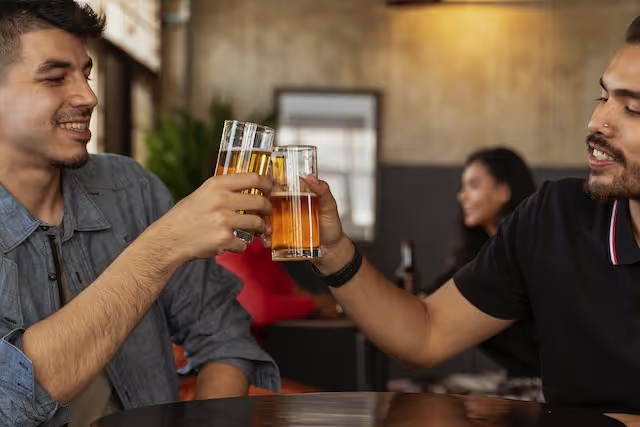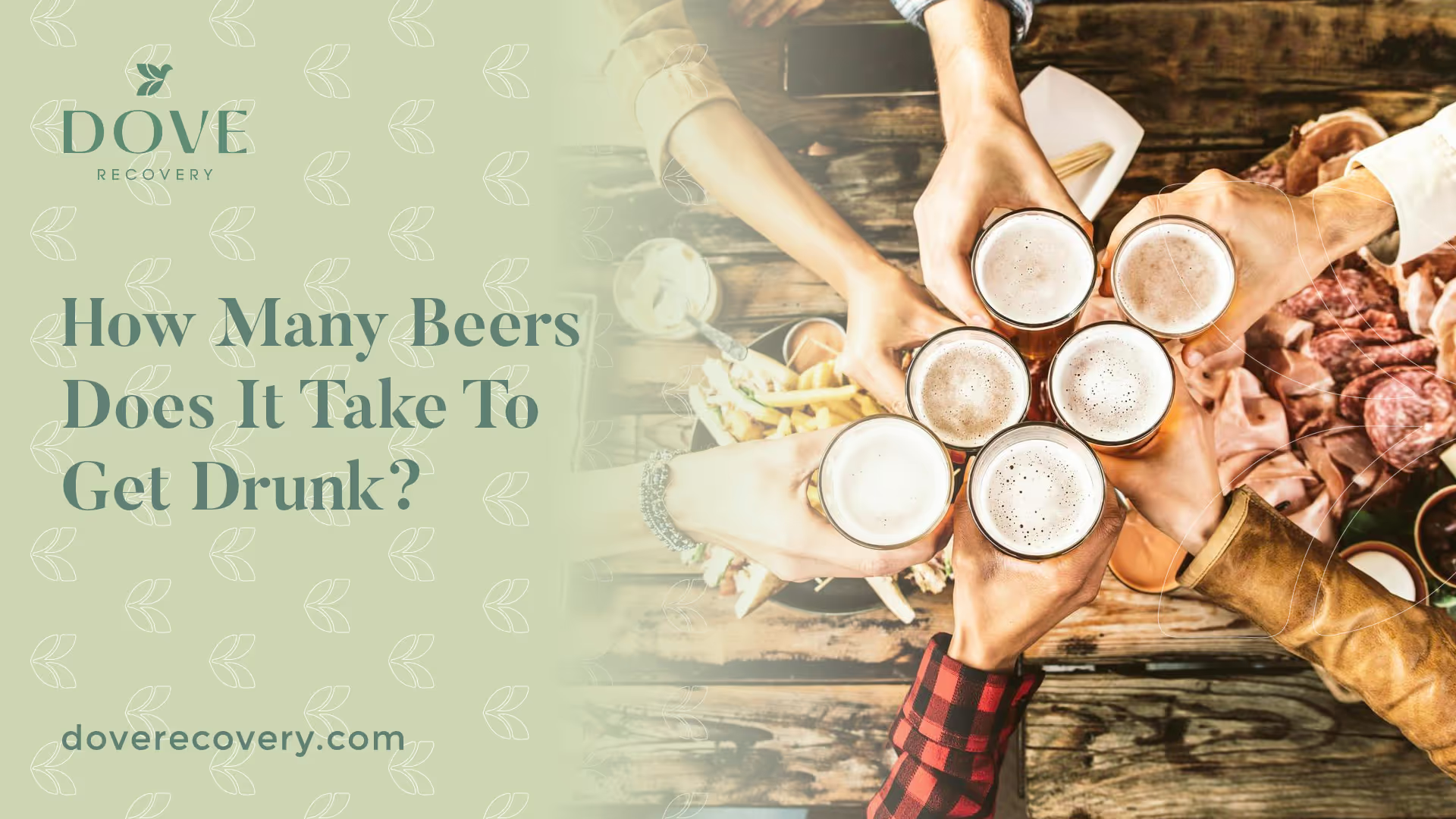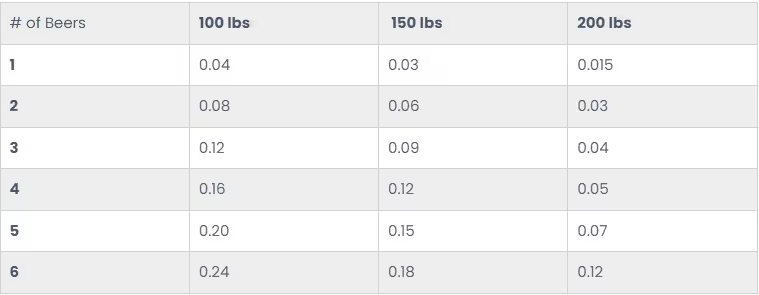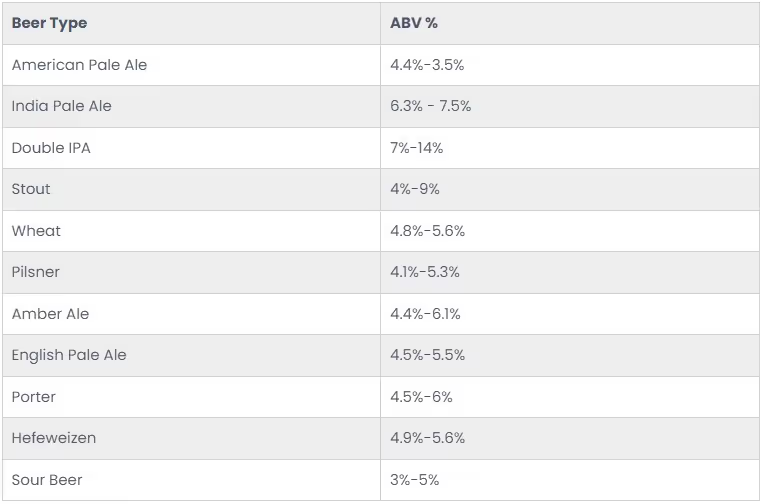How Many Beers Does It Take To Get Drunk?


If you’re a beer lover, you’ve probably wondered how many beers it would take to get drunk. The answer is not as simple as you might think because it depends on many factors, such as your body weight, the alcohol content of the beer, and how quickly you drink.
The Science Behind Beer and Alcohol
Before we dive into how many beers it takes to get drunk, it’s important to understand the science behind beer and alcohol.
The amount of alcohol in beer is measured by alcohol by volume (ABV), which is the percentage of alcohol in the total volume of the drink. A standard beer in the US usually has an ABV of around 5%. This means that for every 12 ounces of beer, there is 0.6 ounces of alcohol.
Definition of Being Drunk
Being drunk is a result of alcohol affecting the central nervous system. When you consume alcohol, it enters your bloodstream and travels to your brain. This is where it affects the neurotransmitters, which are responsible for sending messages throughout your body. As a result, being drunk can cause a range of effects on the body, such as slurred speech, impaired judgment, loss of coordination, and difficulty concentrating.
The severity of these effects depends on how much alcohol you have consumed and how quickly you drank it. It's important to remember that being drunk can impair your ability to make sound decisions and can be dangerous if you're driving or operating heavy machinery.
What is Blood Alcohol Level?
Blood alcohol level (BAL) is the amount of alcohol present in your bloodstream. It's measured as a percentage, and it's used to determine how much alcohol you have consumed and how intoxicated you are. Generally, a BAL of 0.08% or higher is considered legally drunk in the US.
Your blood alcohol level is affected by several factors, including your body weight, gender, age, the amount of food you've eaten, and how quickly you drink. For example, if you weigh less and drink more quickly, your BAL will rise faster than someone who weighs more and drinks at a slower pace.
Here's a chart showing blood alcohol concentration based on a person's weight.

It's important to note that different people can have different reactions to alcohol depending on their tolerance levels and other individual factors. Some people may feel drunk at a lower BAL than others. Additionally, even if you don't feel drunk, driving with a high BAL can still be dangerous and illegal.
Factors That Affect How Many Beers It Takes to Get Drunk
The number of beers it takes to get drunk varies from person to person. Here are the factors that can affect how many beers it takes to get drunk:
Body weight
The more you weigh, the more alcohol you can generally handle. If you’re a larger person, it may take more beers to get drunk than someone who is smaller.
Gender
Women generally have less body water than men, which means they can get drunk faster. This is because alcohol is diluted in water, so the less water in your body, the more concentrated the alcohol will be.
Alcohol tolerance
If you drink frequently, your body builds up a tolerance to alcohol, which means you may need more beers to get drunk.
Food
If you drink on an empty stomach, the alcohol will be absorbed into your bloodstream faster, which means you’ll get drunk faster. Eating food before or while drinking can slow down the absorption of alcohol and reduce the effects of alcohol.
Speed of drinking
If you drink beer quickly, you’ll get drunk faster because your body won’t have time to process the alcohol. Drinking slowly can help your body process the alcohol more effectively.
How Many Beers Does It Take to Get Drunk?
Now that you understand the factors that affect how many beers it takes to get drunk, let's dive a little deeper into this topic.
As I mentioned earlier, the number of beers it takes to get drunk can vary greatly from person to person. In addition to body weight and frequency of drinking, other factors that can affect how quickly you get drunk include your gender, age, and overall health.
For example, women generally have less body water than men, which means that they can become intoxicated more quickly than men after drinking the same amount of alcohol. Similarly, as we age, our bodies become less efficient at metabolizing alcohol, which means that it takes less alcohol to get us drunk.
It's also important to note that the type of alcohol you consume can affect how quickly you get drunk. Beer typically has a lower alcohol content than wine or hard liquor, so you may need to drink more beer to get the same effect as a glass of wine or a shot of whiskey.
Finally, it's important to remember that even if you don't feel drunk, you may still be impaired. Alcohol can affect your judgment, reaction time, and coordination, even if you don't feel like you're stumbling or slurring your words. So if you've been drinking, it's always best to err on the side of caution and avoid driving or operating heavy machinery.
What are the Stages of Drunkenness?
When it comes to drinking alcohol, individuals can experience different stages of drunkenness, which are often categorized as follows:
Euphoria
The euphoric stage is typically the first stage of drunkenness. During this stage, a person may feel relaxed and happy. They may also become more talkative and social.
Excitement
As a person continues to drink, they may enter the excitement stage. During this stage, a person's inhibitions may start to lower, which can lead to increased risk-taking behaviors. They may also experience impaired judgment and difficulty with coordination.
Confusion
After the excitement stage comes confusion. This is where things start to get hazy for the individual. They may struggle to speak clearly or complete simple tasks like walking in a straight line.
Stupor
Finally, as a person continues to drink heavily, they will enter the stupor phase. This is where their body starts to shut down due to alcohol poisoning. At this point, it's crucial that the individual receives medical attention immediately.
It's worth noting that not everyone experiences all four stages of drunkenness, and some individuals may move through them more quickly or slowly than others. Nevertheless, it's essential to drink responsibly and stay within your limits to avoid any adverse effects associated with excessive alcohol consumption.
In conclusion, understanding the stages of drunkenness can help individuals make informed decisions about their alcohol consumption and prevent negative consequences associated with excessive drinking.
How To Not Get Drunk Fast
Now that we’ve discussed what factors contribute towards getting drunk fast let’s talk about some ways in which we can avoid getting drunk too fast:
Drink water in between alcoholic drinks
Drinking water helps dilute the concentration of alcohol in your blood. When consuming alcoholic drinks make sure to drink water in between to keep yourself hydrated.
Choose drinks with lower ABV
If you’re looking to enjoy a night out without getting drunk, consider choosing drinks with lower alcohol by volume. Light beers or wine spritzers can be a good option for this.
Avoid sugary and carbonated drinks
Sugary and carbonated drinks tend to make you feel full faster, which can slow down the absorption of alcohol. However, they also tend to increase the rate at which alcohol is absorbed into your bloodstream, which means that you may get drunk faster if you mix sugary or carbonated drinks with alcohol.
Eat before drinking
Eating food before drinking helps slow down the absorption of alcohol into your bloodstream. Eating foods high in protein or fats can be particularly helpful as they take longer to digest.
By following these tips, you’ll be able to enjoy a night out without worrying about getting too drunk too fast. However, it’s always important to remember that even if you don’t feel drunk, you may still be impaired and should avoid driving or operating heavy machinery after consuming alcoholic beverages.
Effects of Different Types of Beers on Drunkenness
As mentioned earlier, the alcohol content of beer is measured by ABV. However, the type of beer you consume can also have an impact on how quickly you get drunk.
For example, a light beer typically has a lower ABV than a dark beer or a craft beer. This means that it may take more light beers to get drunk than it would take to get drunk on fewer dark or craft beers.
In addition to ABV, the ingredients and brewing process used to create different types of beers can also affect how quickly you get drunk. For instance, some beers are brewed with higher sugar content, which can cause your blood sugar levels to spike and lead to faster absorption of alcohol into your bloodstream.
Check out the table below for the ABV percentages of different types of beer.

It's worth noting that while different types of beers can affect how quickly you get drunk, they all contain alcohol and should be consumed in moderation. Regardless of the type of beer you choose to drink, it's important to be aware of how much you're consuming and how it's affecting your body.
In conclusion, while certain factors like body weight, gender, and food intake can influence how many beers it takes to get drunk, the type of beer you drink can also play a role in your level of drunkenness. It's always best to drink responsibly and make sure you're aware of your limits before consuming alcohol.
The Best Ways to Sober Up After Drinking Too Much Beer
If you've had too much beer and need to sober up quickly, there are a few things you can do to help your body process the alcohol more effectively. Here are some of the best ways to sober up after drinking too much beer:
Drink water
Drinking water is one of the easiest and most effective ways to help your body flush out alcohol. Alcohol is a diuretic, which means it can cause dehydration. Drinking water can help rehydrate your body and dilute the concentration of alcohol in your bloodstream.
Eat a meal
Eating a meal can help slow down the absorption of alcohol into your bloodstream. Foods high in protein or fats take longer to digest, which means they can help prevent a rapid spike in blood alcohol levels.
Take a nap
Taking a nap can give your body time to process the alcohol and allow you to wake up feeling more alert and less impaired. However, it's important to remember that sleeping does not actually reduce the amount of alcohol in your system.
Exercise
Exercising can help speed up your metabolism and increase circulation, which can help your body process alcohol more quickly. However, it's important not to overdo it as exercising while intoxicated can be dangerous.
Time
The only way for alcohol to leave your system is through time. Your liver processes about one standard drink per hour on average, so if you've had multiple beers, it may take several hours for all of the alcohol to leave your system.
Remember that these methods may make you feel better temporarily but they do not actually reduce the amount of alcohol in your system. It's always best to drink responsibly and avoid getting too drunk in the first place. If you're going out drinking, make sure you have a plan for how you'll get home safely without driving or operating heavy machinery while impaired.
How Many Drinks is Too Much?
This is a common question that people ask when it comes to drinking alcohol. The answer depends on several factors, including your body weight, gender, age, and overall health.
In general, experts recommend that:
- Women should consume no more than one drink per day
- Men should consume no more than two drinks per day
However, these guidelines are just that – guidelines. They may not apply to everyone and should be adjusted based on individual factors.
Binge Drinking
It's also important to note that binge drinking can have serious health consequences. Binge drinking is defined as consuming:
- Four or more drinks for women
- Five or more drinks for men
Within a two-hour period. This type of heavy drinking can lead to alcohol poisoning, which can be life-threatening.
Risks
In addition to the physical health risks associated with excessive alcohol consumption, there are also social and legal consequences to consider. Drinking too much can impair your judgment and coordination, making it dangerous to drive or operate heavy machinery. It can also lead to poor decision-making and risky behaviors.
Ultimately, the key is to drink responsibly and know your limits. If you're going out drinking with friends, make sure you have a plan in place for how you'll get home safely without driving or operating heavy machinery while impaired. And if you're concerned about your drinking habits or those of someone you know, don't hesitate to seek help from a healthcare professional or addiction specialist.
Conclusion
In conclusion, there is no one-size-fits-all answer to how many beers it takes to get drunk. It depends on many factors, including your body weight, gender, alcohol tolerance, food intake, and speed of drinking. However, as a general rule, it takes about 3-4 beers to get drunk for an average person.
Remember to always drink responsibly and never drink and drive. If you’re unsure how much alcohol you can handle, start with a small amount and drink slowly. And if you or someone you know has a problem with alcohol, seek help from a medical professional.
Sources:
- National Institute on Alcohol Abuse and Alcoholism. (n.d.). Alcohol Facts and Statistics. Retrieved from https://www.niaaa.nih.gov/publications/brochures-and-fact-sheets/alcohol-facts-and-statistics
- Centers for Disease Control and Prevention. (2019). Fact Sheets - Alcohol Use and Your Health. Retrieved from https://www.cdc.gov/alcohol/fact-sheets/alcohol-use.htm
